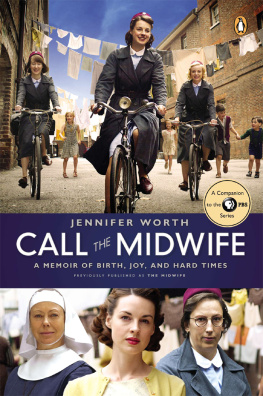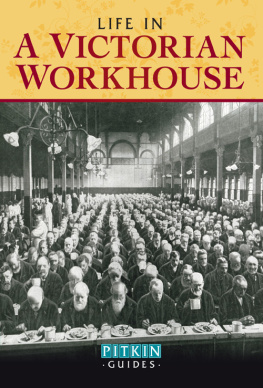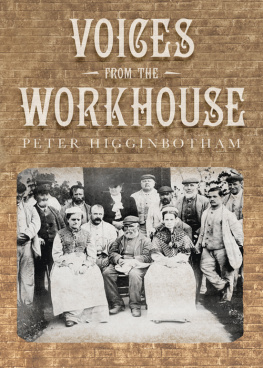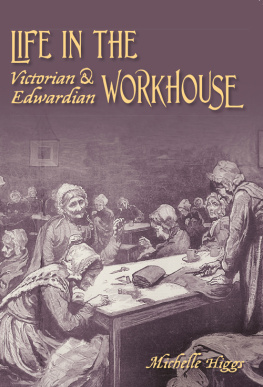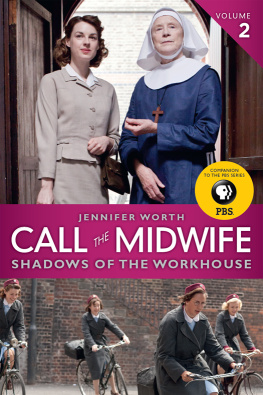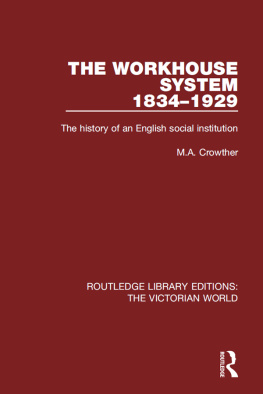Jennifer Worth - Shadows Of The Workhouse: The Drama Of Life In Postwar London
Here you can read online Jennifer Worth - Shadows Of The Workhouse: The Drama Of Life In Postwar London full text of the book (entire story) in english for free. Download pdf and epub, get meaning, cover and reviews about this ebook. genre: Non-fiction. Description of the work, (preface) as well as reviews are available. Best literature library LitArk.com created for fans of good reading and offers a wide selection of genres:
Romance novel
Science fiction
Adventure
Detective
Science
History
Home and family
Prose
Art
Politics
Computer
Non-fiction
Religion
Business
Children
Humor
Choose a favorite category and find really read worthwhile books. Enjoy immersion in the world of imagination, feel the emotions of the characters or learn something new for yourself, make an fascinating discovery.

- Book:Shadows Of The Workhouse: The Drama Of Life In Postwar London
- Author:
- Genre:
- Rating:5 / 5
- Favourites:Add to favourites
- Your mark:
- 100
- 1
- 2
- 3
- 4
- 5
Shadows Of The Workhouse: The Drama Of Life In Postwar London: summary, description and annotation
We offer to read an annotation, description, summary or preface (depends on what the author of the book "Shadows Of The Workhouse: The Drama Of Life In Postwar London" wrote himself). If you haven't found the necessary information about the book — write in the comments, we will try to find it.
Shadows Of The Workhouse: The Drama Of Life In Postwar London — read online for free the complete book (whole text) full work
Below is the text of the book, divided by pages. System saving the place of the last page read, allows you to conveniently read the book "Shadows Of The Workhouse: The Drama Of Life In Postwar London" online for free, without having to search again every time where you left off. Put a bookmark, and you can go to the page where you finished reading at any time.
Font size:
Interval:
Bookmark:
Jennifer Worth
Shadows Of The Workhouse: The Drama Of Life In Postwar London
ACKNOWLEDGEMENTS
Maysel Brar, for legal advice; Douglas May, Peggy Sayer, Betty Hawney, Jennie Whitefield, Joan Hands and Helen Whitehorn for advice, proof-reading, typing and checking; Philip and Suzannah, for everything; all the kind people who have written to me about the workhouse system, particularly Kathleen Daley and Dennis Strange; Chris Lloyd, Bancroft Library, Mile End, London; Jonathan Evans, Royal London Hospital Archives, London; Eve Hostettler, Island History Trust, the Isle of Dogs, London E14; Jean Todd, Allan Young and Jeff Wright for help with archive pictures; London Metropolitan Archives, London EC1; Hackney Archives, London N1; Camden Local Studies and Archives Centre; The Local History Collection of Gravesend Library, Kent; Peter Higginbotham for his help in checking the material on the history of the workhouse.
Part I
WORKHOUSE CHILDREN
NONNATUS HOUSE
Nonnatus House was both a convent and the working base for the nursing and midwifery services of the Sisters of St Raymund Nonnatus.1 The house was situated in the heart of the London Docklands and the practice covered Poplar, the Isle of Dogs, Stepney, Limehouse, Millwall, Bow, Mile End and parts of White-chapel. I worked with the Sisters in the 1950s. It was a time, shortly after the Second World War, when the scars of the devastated city could be seen everywhere bomb sites, blown-out shops, closed streets and roofless houses (often inhabited). It was a time when the docks were fully operational, and millions of tons of cargo poured in and out every day. Huge merchant vessels sailed up the Thames, to be piloted into the wharves through a complex system of canals, locks and basins. It was not unusual to pass along a road within a few feet of the towering hulk of a merchant ship. Even in the 1950s about sixty per cent of all cargo was unloaded manually, and the ports teemed with labourers. Most of them lived with their families in the little houses and tenements around the docks.
Families were large, sometimes huge, and living conditions cramped. In fact, by todays standards, the living conditions would be considered Dickensian. Most dwellings had running cold water, but no hot water. About half had an indoor lavatory, but for the other half the lavatory was outside, usually shared with other families. Very few homes had a bathroom. A bath was taken in a tin bath placed on the floor of the kitchen or living room, though public bath houses were also frequently used. Most houses had electric light, but gaslight was still common, and I have delivered many a baby by this flickering light, as well as by torchlight or hurricane lamp.
It was a time just before the social revolution of the Pill, and women tended to have many children. A colleague of mine delivered an eighteenth baby to one woman and I delivered a twenty-fourth! Admittedly these were extreme cases, but ten babies was quite common. Although the fashion for hospitalisation for a birth was fast gaining ground, this fashion had not affected the Poplar women, who were slow to change, and a home birth was still preferred. Earlier in the century, even as little as twenty or thirty years previously, women were still delivering each others babies as they had done in earlier centuries, but by the 1950s, with the advent of the National Health Service, all pregnancies and births were attended by trained midwives.
I worked with the Sisters of St Raymund Nonnatus, a religious order of Anglican nuns with a history dating back to the 1840s. This was also a nursing order pioneered at a time when nurses were commonly regarded as the dregs of female society. The Sisters, bound for life by the monastic vows of poverty, chastity and obedience, had been in Poplar since the 1870s. They started their work at a time when there was virtually no medical help for the poorest of the poor, and a woman and her baby survived or died unattended. The Sisters lived a life of ceaseless dedication to their religion and to the people whom they felt were in their care. At the time when I worked at Nonnatus House, Sister Julienne was Sister-in-Charge.
Convents tend to attract within their portals ladies of middle years who are unable to cope with life in one way or another. These ladies are always single, widowed or divorced, and lonely. They are nearly always gentle, timid and shy, with an immense yearning for the goodness which they see in the convent but cannot find in the harsh world outside. Usually they are very devout in points of religious observance and have an unrealistic or romanticised idea of monastic life and long to be part of it. However, they often do not have a true vocation that would enable them to take the life vows of poverty, chastity and obedience. Nor, I suspect would they possess the strength of character necessary to live within these vows. So they hover on the fringe, neither fully within the world, nor withdrawn from it.
Such a lady was Jane. She was probably around forty-five when I met her, but she looked much older. She was, tall, thin, aristocratic in appearance, with delicate bone structure, beautifully sculpted features, and refined manners. In another context she would have been an outstanding beauty, but her excessive dowdiness made her look plain and nondescript. It was almost as if she did it on purpose. Her soft grey hair could have curled prettily around her face, but she cut it herself, so that it was jagged and shapeless. Her height, which should have rendered her distinguished, she reduced by bending her shoulders, so that her carriage and walk were stooped and cringing. Her large, expressive eyes were filled with nameless anxiety and surrounded by worry lines. Her speech was so soft that it sounded like a far-off twitter, and her laugh a nervous giggle.
In fact, nervousness was her chief characteristic. She seemed frightened of everything. I noticed that, even at meals, she did not dare to pick up her knife and fork until everyone else had done so, and when she did, her hands frequently shook so much that she would drop something. Then she had to apologise profusely to everyone, especially to Sister Julienne, who was always at the head of the table.
Jane had lived at Nonnatus House for many years and fulfilled a role that was neither nurse, nor domestic servant, but a mixture of the two. I had the impression she was a highly intelligent woman who could easily have trained as a nurse, and been very good at it, but something must have prevented her. No doubt it was her chronic nervousness, for she could never have taken the responsibility that is a daily part of any nurses life. So Sister Julienne sent her out to do simple jobs, like blanket baths, or enemas, or delivering various things to patients. In doing these little jobs, Jane was all of a twitter with anxiety, going over and over her bag obsessively, muttering to herself such things as, Soap, towels. Have I got everything? Is it all there? Consequently it took her two or three hours to do a job that any competent nurse could have achieved in twenty minutes. When she had finished, she was pathetically eager for recognition, her eyes almost pleading for someone to say that she had done well. Sister Julienne always praised her small achievements, but I could see that it was a strain for her to be so constantly alert to Janes craving for praise.
Jane also helped the nurses and midwives in the clinical room in small ways, such as cleaning instruments, packing bags and so on, and again she was irritatingly eager to please. Asked for a syringe, she would rush off and get three. Asked for some cotton-wool swabs for one baby, she would bring enough for twenty and then almost grovel as she handed over the item with a nervous giggle. This craven urge to please brought her no rest, no comfort.
Font size:
Interval:
Bookmark:
Similar books «Shadows Of The Workhouse: The Drama Of Life In Postwar London»
Look at similar books to Shadows Of The Workhouse: The Drama Of Life In Postwar London. We have selected literature similar in name and meaning in the hope of providing readers with more options to find new, interesting, not yet read works.
Discussion, reviews of the book Shadows Of The Workhouse: The Drama Of Life In Postwar London and just readers' own opinions. Leave your comments, write what you think about the work, its meaning or the main characters. Specify what exactly you liked and what you didn't like, and why you think so.

